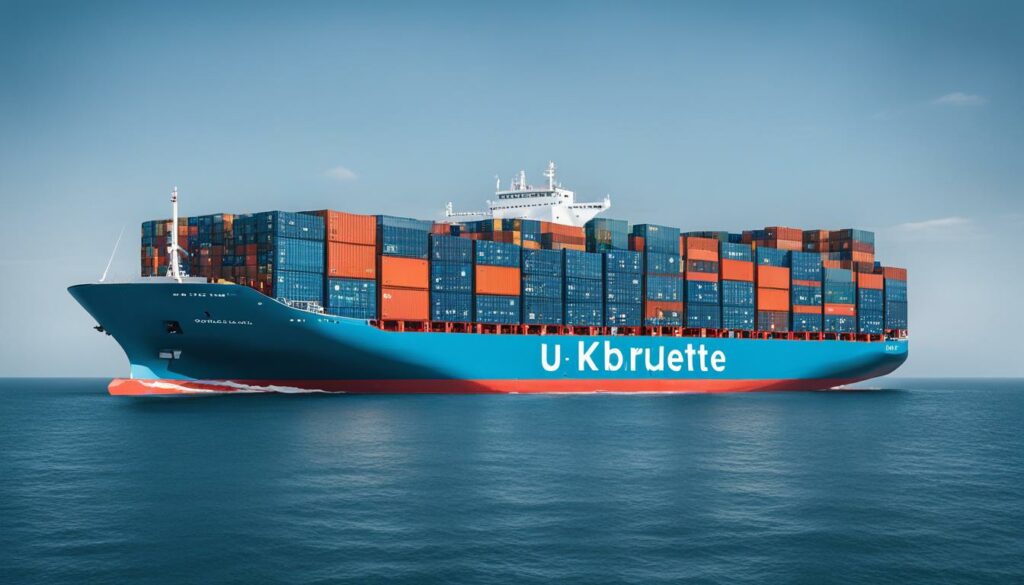Welcome to the world of Kubernetes! If you’re new to containerized applications and looking to simplify their deployment, scaling, and management, then Kubernetes is the answer. In this article, we’ll give you an overview of Kubernetes, explain its basics, and show you how it can revolutionize your web application development process.
So, what is Kubernetes? It’s an open-source orchestration system that allows you to automate and streamline the continuous deployment of your code. With Kubernetes, you can easily manage complex applications, improve engineering productivity, and ship code multiple times per day. This means faster application delivery and simplified infrastructure management.
Getting started with Kubernetes can seem daunting at first, but don’t worry. We’re here to guide you through it! In the following sections, we’ll explain why containers are beneficial, how they work, and dive deeper into the features and capabilities of Kubernetes. We’ll also discuss the challenges you may face and provide solutions to overcome them.
Throughout this article, we’ll use real-life examples and provide actionable tips to help you understand Kubernetes better and make the most out of it for your web applications. So, let’s get started on your Kubernetes journey with the help of BoostedHost, our recommended WordPress Hosting provider for optimal performance.
Key Takeaways:
- Kubernetes is an open-source orchestration system that simplifies the deployment, scaling, and management of containerized applications.
- Containerization offers benefits like portability, modularity, security, and scalability.
- Docker is a popular container technology used to build, run, test, and deploy distributed applications.
- Kubernetes provides features like automated rollouts, service discovery, storage orchestration, and self-healing capabilities.
- Challenges in using Kubernetes include complexity, configuration management, and cost management.
Now that you have a glimpse of what Kubernetes has to offer, let’s dive deeper into the world of containers and explore the exciting possibilities they bring.
Remember, BoostedHost’s WordPress Hosting is here to enhance your Kubernetes experience. Sign up now through this link: www.boostedhost.com/wordpress-hosting
Why Use Containers?
Containers offer numerous benefits for application deployment and management. Whether you’re a developer, system administrator, or IT team, containerization can revolutionize your workflow. Here are some key reasons why containers have become an integral part of modern technology:
- Portability: Containers allow applications to run consistently across different environments, making it easier to deploy and manage code. By encapsulating applications, their dependencies, and runtime libraries, containers eliminate compatibility issues and ensure consistent execution.
- Modularity: Container technology enables the separation of application stack components, allowing for easy interchangeability. If you need to update a specific component or switch to a different version, containers make it simple to make isolated changes without impacting the entire system.
- Enhanced Security: Containers isolate applications from each other and the host system, providing an added layer of security. This isolation prevents any potential vulnerabilities in one container from spreading to others. Additionally, containers can run with minimal privileges, reducing the attack surface and improving overall system security.
- Scalability: Containers are designed to efficiently utilize resources, enabling horizontal scaling in response to varying workload demands. With container orchestration platforms like Kubernetes, you can easily scale your applications up or down, ensuring optimal performance and resource allocation.
Containerization: A Tidy Packaging Solution
Containerization is a clean and efficient way to package code with all its dependencies. It encapsulates the entire runtime environment, eliminating the need to install and configure dependencies on individual systems. This makes it easier to deploy applications consistently across different environments without worrying about potential conflicts or compatibility issues.
Using containers allows you to ship applications confidently, knowing that they will run without any surprises, regardless of the underlying infrastructure.
Containers also simplify the management process by ensuring consistency across development, testing, and production environments. Developers can focus on writing code, while system administrators can manage containers and their dependencies more effectively.
How Do Containers Work?
Containers have revolutionized the way applications are built, deployed, and managed. At the heart of containerization is Docker, a popular technology that enables developers to create, run, test, and deploy distributed applications efficiently.
A container image serves as the foundation for creating containers. It contains all the necessary software components, including the application code and its dependencies. Think of it as a blueprint that ensures consistent execution across different systems, regardless of the underlying infrastructure.
Now, you might be wondering, what exactly is a container? Well, a container is a lightweight, standalone virtual environment that packages the application and its dependencies together. It encapsulates everything needed to run the application, from the code to the runtime environment and dependencies. This means that you can create a container once and run it anywhere without worrying about compatibility issues.
But how do containers work together in a complex environment? This is where container orchestration comes into play. Container orchestration is the coordination and management of container behaviors, such as scheduling, resource management, and load balancing.
Quote:
“Container orchestration allows you to automate and simplify the management of containers, making it easier to maintain and scale your applications.”
One of the most popular container orchestration platforms is Kubernetes. Kubernetes acts as an orchestration engine, automating various tasks involved in managing containers and ensuring their smooth operation.
With Kubernetes, you can easily deploy, scale, and manage containerized applications across clusters of machines. It provides features like automated scaling, load balancing, and self-healing, which are essential for running applications in a distributed and scalable manner.
Now that you have a better understanding of how containers work, let’s take a closer look at the features and capabilities of Kubernetes in the next section.

| Container Image | Container | Container Orchestration |
|---|---|---|
| Contains the necessary software components | A lightweight, standalone virtual environment | Coordinates and manages container behaviors |
| Ensures consistent execution across systems | Packages application code with its dependencies | Automates tasks like scheduling and resource management |
Introduction to Kubernetes
Kubernetes is a powerful tool that offers a wide range of features and capabilities for effectively managing containerized applications.
Automated Rollouts and Rollbacks
With Kubernetes, you can ensure smooth deployment and configuration changes through automated rollouts and rollbacks. This allows you to easily update and modify your applications without disruptions.
Service Discovery and Load Balancing
Kubernetes provides built-in service discovery and load balancing capabilities, simplifying application communication and the distribution of traffic. This enables seamless interactions between various components of your application.
Storage Orchestration
Kubernetes supports storage orchestration, allowing for the automatic mounting of various storage systems. This makes it easy to manage and utilize different storage resources efficiently.
Self-Healing
One of the key highlights of Kubernetes is its self-healing feature. It automatically detects and restarts or replaces failed containers, ensuring the continuous availability and stability of your applications.
Secret and Configuration Management
Kubernetes offers secure secret and configuration management, allowing you to deploy and update application settings while maintaining proper security measures. This ensures that sensitive information remains protected.
| Kubernetes Features | Kubernetes Capabilities |
|---|---|
| Automated Rollouts and Rollbacks | Smooth deployment and configuration changes |
| Service Discovery and Load Balancing | Simplified application communication and traffic distribution |
| Storage Orchestration | Automatic mounting of various storage systems |
| Self-Healing | Automatic restart or replacement of failed containers |
| Secret and Configuration Management | Secure deployment and update of application settings |
Overall, Kubernetes provides a robust set of features and capabilities that enable efficient management of containerized applications. These features enhance automation, scalability, and security, making Kubernetes a valuable tool for organizations looking to streamline their application deployment and management processes.

Challenges of Using Kubernetes
While Kubernetes offers numerous benefits, it also presents various challenges that organizations must overcome. The complexity of Kubernetes can slow down adoption and hinder container usage. Writing and managing YAML/JSON manifests for Kubernetes configuration can be time-consuming and error-prone. It requires a high level of knowledge and attention to detail to configure components and work with object types effectively.
Furthermore, managing costs in Kubernetes can be a challenge. Overprovisioning, unpredictable expenses, and difficulty in tracking resource usage can lead to increased costs. It’s crucial for organizations to implement efficient cost management strategies to optimize cost efficiency and avoid budget overruns.
To summarize, the challenges of using Kubernetes include:
- Kubernetes complexity
- Configuration challenges
- Cost management in Kubernetes
Overcoming these challenges requires a deep understanding of Kubernetes concepts, careful configuration management, and efficient resource allocation. It’s important to continuously evaluate and optimize configurations to ensure smooth operation and cost-effective resource utilization.
Example Quote:
“Efficiently managing Kubernetes complexity, configurations, and costs is essential for organizations to fully benefit from containerization and orchestration.” – Kubernetes expert
Tips for Overcoming Kubernetes Challenges:
- Spend time learning and understanding Kubernetes concepts to navigate its complexity effectively.
- Implement best practices for managing configurations and regularly review and update them as needed.
- Monitor resource usage closely to identify and eliminate overprovisioning and optimize cost efficiency.
- Consider utilizing Kubernetes management tools and platforms that provide cost optimization features.
Comparison of Kubernetes Challenges
| Challenges | Impact | Solutions |
|---|---|---|
| Kubernetes Complexity | Slower adoption and hindered container usage | Invest time in learning Kubernetes concepts and utilize training resources |
| Configuration Challenges | Time-consuming and error-prone configuration management | Implement best practices, utilize templates, and automate configuration processes |
| Cost Management in Kubernetes | Increased costs due to overprovisioning and difficulty in tracking resource usage | Regularly monitor resource usage, implement efficient resource allocation strategies, and leverage cost optimization tools |

Scaling and Automation with Kubernetes
Kubernetes provides a dynamic scaling feature that allows efficient resource allocation based on the workload demand. With dynamic scaling in Kubernetes, you can automatically manage container instances to handle fluctuations in usage, ensuring responsiveness even under heavy loads. This feature optimizes resource utilization and prevents overprovisioning, ultimately reducing costs and enhancing performance.
Furthermore, Kubernetes offers a high level of autonomy in managing containerized applications. It automates time-consuming tasks such as load balancing, scaling, and self-healing, allowing you to focus on other critical aspects of application development and deployment. The autonomy provided by Kubernetes streamlines the application deployment process, enhances high availability, and simplifies infrastructure management.
By harnessing the power of dynamic scaling and autonomy in Kubernetes, you can achieve streamlined application deployment, efficient resource allocation, and improved overall system performance. With Kubernetes, you no longer have to worry about manual scaling or resource allocation, as the platform takes care of these tasks for you, ensuring optimal performance and resource utilization.
Benefits of Scaling and Autonomy in Kubernetes:
- Efficient resource allocation based on workload demand
- Automatic management of container instances under heavy loads
- Streamlined application deployment process
- Enhanced high availability and fault tolerance
- Simplified infrastructure management
“With dynamic scaling and autonomy in Kubernetes, you can effortlessly handle fluctuating workloads, optimize resource utilization, and ensure efficient application deployment.”
| Scaling and Automation Features | Benefits |
|---|---|
| Dynamic scaling based on workload demand | Efficient resource utilization, improved performance |
| Automatic management of container instances | Enhanced high availability, fault tolerance |
| Streamlined application deployment process | Time saved, faster time-to-market |
| Simplified infrastructure management | Reduced operational complexity |
Overcoming Configuration Complexity in Kubernetes
Configuring components in Kubernetes can be complex, especially when dealing with YAML/JSON manifests. Manifests provide instructions on how to utilize resources within a cluster, but they require a deep understanding of object types and their specific requirements. This level of configuration management is essential for ensuring smooth operation and optimal allocation of resources.
Alongside configuration, Kubernetes administration plays a crucial role in maintaining the infrastructure. As an administrator, you are responsible for validating pod resource limits, enforcing security policies, and managing third-party plugins or extensions. Regular evaluation and management of configurations are necessary to keep your Kubernetes environment running efficiently and securely.
“Proper configuration management is key to maintaining the stability and performance of your Kubernetes cluster. It allows you to optimize resource allocation, improve security, and ensure the smooth operation of your applications.” – Kubernetes expert
However, managing configurations in Kubernetes can be challenging and time-consuming. The complexity of YAML/JSON manifests requires meticulous attention to detail and a solid understanding of the Kubernetes object model. Any misconfigurations or errors can lead to application failures or security vulnerabilities.
To simplify configuration management in Kubernetes, consider leveraging tools and frameworks that provide abstractions and automation. These solutions can simplify the process of creating, validating, and managing manifests, reducing the potential for errors and improving operational efficiency.
Manifest Management Tools
Various tools and frameworks are available to assist with managing Kubernetes manifests:
- Kustomize: A native Kubernetes configuration management tool that simplifies managing multiple overlays and customization options.
- Helm: A popular package manager for Kubernetes that allows you to define, install, and manage applications and their dependencies using Helm charts.
- ksonnet: A flexible framework for Kubernetes configuration management, providing a powerful way to generate and manage Kubernetes resources.
By utilizing these tools, you can streamline the configuration management process and benefit from improved productivity and reduced complexity.
Comparison of Manifest Management Tools
| Tool | Key Features | Benefits |
|---|---|---|
| Kustomize |
|
|
| Helm |
|
|
| ksonnet |
|
|
Using these tools, you can enhance your configuration management workflows and ensure consistency and reliability across your Kubernetes deployments.

With the right tools and a solid understanding of manifest management, you can overcome the complexity of configuring components in Kubernetes. By optimizing your configuration processes, you’ll receive the full benefits of Kubernetes, including scalability, flexibility, and efficient resource allocation.
Managing Costs in Kubernetes
Controlling costs in Kubernetes is essential for optimizing resource usage and maximizing cost efficiency. With the dynamic and unpredictable nature of resource consumption, it is crucial to monitor and track usage effectively. Failure to manage costs can lead to overprovisioning, resulting in wasted resources and increased expenses.
To ensure cost-efficient operations, it is important to properly configure the resource requirements of your applications. By accurately assessing the necessary resources, you can avoid allocating more than what is actually needed. Continuously monitoring resource usage allows you to identify any inefficiencies or excessive consumption, providing an opportunity for optimization.
“Properly configuring application resource requirements and continuously monitoring usage can optimize cost efficiency.”
In addition to configuration management, tracking resource usage is crucial for understanding your cost drivers in Kubernetes. By monitoring the usage patterns of your applications and infrastructure, you can identify areas where resource allocation can be optimized. Regular monitoring enables you to detect unused or underutilized resources, reducing unnecessary spending.
Effective cost management strategies also involve predictive analysis. By analyzing historical usage data, you can forecast future resource requirements, allowing for proactive resource allocation and optimization. This approach helps prevent budget overruns and ensures that resources are used efficiently.
Cost Management Tips:
- Regularly monitor resource usage and make adjustments as needed
- Identify and eliminate wasted capacity to reduce costs
- Implement predictive analysis to forecast future resource requirements
- Optimize resource allocation to maximize cost efficiency
By effectively managing costs in Kubernetes, you can ensure that your resource usage is aligned with your budget and application needs. This not only leads to financial savings but also helps maintain a scalable and efficient infrastructure.
Dealing with Complexity in Kubernetes
As Kubernetes scales, handling its complexity becomes crucial, especially when it comes to managing networking policies and configurations. Coordinating and overseeing multiple clusters, each with unique resource requirements, adds another layer of intricacy to the equation.
One of the challenges in scaling Kubernetes is ensuring consistent traffic flow and network security. This requires a careful consideration of network policy rules, ensuring that communication between different application components is seamless while maintaining robust security measures.
Furthermore, keeping up with best practices, updates, and emerging trends is essential to navigate the ever-evolving landscape of Kubernetes effectively. Staying informed about the latest advancements enables you to optimize your Kubernetes deployment, overcome potential challenges, and leverage new features that enhance scalability and performance.
Scaling Challenges in Kubernetes
Scaling Kubernetes brings its own set of unique challenges. While Kubernetes offers automated scaling capabilities to handle workload fluctuations, ensuring efficient resource allocation requires careful planning.
One challenge is optimizing resource utilization. When scaling Kubernetes, it’s essential to strike the right balance between providing enough resources to handle increased demand and avoiding overprovisioning, which can lead to wasted resources and higher costs.
Another challenge is automating the configuration process and maintaining consistency across multiple clusters. As the number of clusters grows, managing and synchronizing configurations become more intricate, necessitating robust tools and processes to ensure consistent deployment and configuration management.
Consistent Networking Policies
Consistent networking policies play a vital role in managing Kubernetes complexities. By defining and enforcing network policies, you can control traffic between pods and ensure secure and efficient communication within your Kubernetes environment.
Implementing network policies allows you to set granular rules, such as controlling ingress and egress traffic, filtering based on source IP addresses, and enforcing encryption protocols. These policies provide an extra layer of security, ensuring that only authorized traffic flows within your clusters.
Moreover, consistent networking policies enable you to enforce compliance and governance standards across your Kubernetes infrastructure, ensuring that applications adhere to organizational guidelines and industry regulations.
“Network policy is a critical aspect of managing Kubernetes complexity. By implementing consistent networking policies, you can ensure secure communication and control traffic within your Kubernetes environment.”
| Challenges in Scaling Kubernetes | Solutions |
|---|---|
| Optimizing resource allocation | Implement resource monitoring and optimization strategies. Use autoscaling and horizontal pod autoscaling to dynamically adjust resources based on workload demand. |
| Managing configurations across multiple clusters | Adopt centralized configuration management tools to ensure consistency across clusters. Implement configuration as code practices to automate and synchronize configuration updates. |
| Enforcing consistent networking policies | Define network policies to control traffic flow and enforce security measures between pods. Regularly review and update network policies to adapt to changing requirements. |
By overcoming these scaling challenges and establishing consistent networking policies, you can effectively handle the complexity of Kubernetes and unlock its full potential for scalable and resilient application deployments.
Conclusion
In summary, Kubernetes is an essential tool for efficient container management. It offers automation, scalability, and streamlined deployment processes, allowing organizations to achieve faster application delivery and improved scalability. While Kubernetes presents challenges, such as complexity and cost management, these hurdles can be overcome by understanding Kubernetes concepts, optimizing configurations, and implementing efficient resource allocation strategies. By investing time and effort into learning and mastering Kubernetes, organizations can greatly benefit from simplified infrastructure management and enhanced productivity.
Key takeaways from this introduction to Kubernetes include its ability to simplify the deployment, scaling, and management of containerized applications, as well as its support for continuous deployment and improved engineering productivity. Kubernetes offers service discovery, load balancing, and storage orchestration capabilities, ensuring smooth application communication and efficient resource utilization. It also provides self-healing features and secret and configuration management, enhancing security and deployment flexibility. Moreover, Kubernetes enables dynamic scaling and automation, allowing for efficient resource allocation and streamlined application management.
The importance of Kubernetes in container management cannot be overstated. By leveraging Kubernetes, organizations can optimize their containerized application workflows, achieve faster time-to-market, and enhance scalability. Kubernetes empowers teams to automate and simplify various tasks, including deployment, scaling, and self-healing, resulting in improved application availability and reduced operational complexity. To unlock the full potential of containerized applications, it is crucial for organizations to embrace Kubernetes and invest in learning and mastering its features and capabilities.
FAQ
Q: What is Kubernetes?
A: Kubernetes is an open-source orchestration system that simplifies the deployment, scaling, and management of containerized applications.
Q: What are the benefits of using containers?
A: Containers offer portability, modularity, enhanced security, and scalability for application deployment and management.
Q: What is Docker?
A: Docker is a popular container technology used to build, run, test, and deploy distributed applications.
Q: How does Kubernetes work?
A: Kubernetes acts as an orchestration engine, automating and simplifying container behaviors such as scheduling, resource management, and load balancing.
Q: What features does Kubernetes provide?
A: Kubernetes offers automated rollouts and rollbacks, service discovery and load balancing capabilities, storage orchestration, self-healing features, and secret and configuration management.
Q: What challenges does Kubernetes present?
A: Kubernetes complexity, writing and managing YAML/JSON manifests, configuring components, and managing costs can be challenging when using Kubernetes.
Q: How does Kubernetes enable dynamic scaling?
A: Kubernetes efficiently allocates resources based on workload demand, automatically managing container instances to handle fluctuations in usage.
Q: How can configuration complexity in Kubernetes be overcome?
A: Properly understanding Kubernetes manifests, configuring components, and regularly managing configurations are necessary to ensure smooth operation and resource allocation.
Q: How can costs be managed in Kubernetes?
A: Controlling costs in Kubernetes involves proper configuration of resource requirements, continuous monitoring, and resource optimization.
Q: How can complexity in Kubernetes be managed?
A: Navigating complexity in Kubernetes requires consistent networking policies, managing multiple clusters, and staying updated with best practices and emerging trends.
Q: Why is Kubernetes important in container management?
A: Kubernetes provides automation, scalability, and streamlined deployment processes, resulting in faster application delivery, improved scalability, and simplified infrastructure management.












